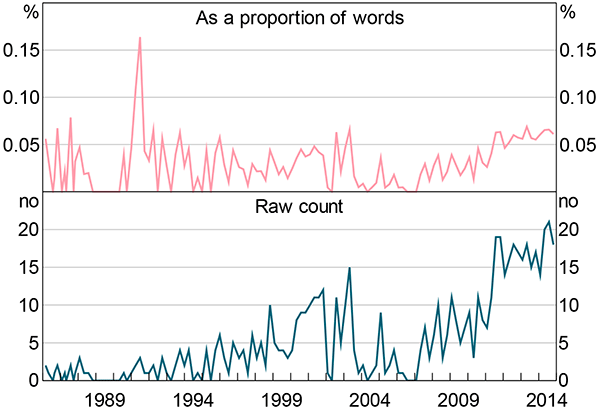RDP 2016-01: Measuring Economic Uncertainty and Its Effects Appendix A: Other Measures of Uncertainty
February 2016
- Download the Paper 1.07MB
- Data
An alternative measure of uncertainty used by Baker et al (2015) is the frequency of the word ‘uncertain’ (or variants) in the Federal Reserve's ‘Beige Book’. I construct an analogous measure for Australia from the RBA's Statement on Monetary Policy (or earlier equivalent publications such as the ‘Quarterly Report on the Economy and Financial Markets’).[30] Figure A1 shows this measure as a proportion of the approximate total number of words in the publication.[31]

Sources: Author's calculations; RBA
The measure is volatile because ‘uncertain’ is used infrequently. Even in the February 2015 Statement on Monetary Policy (SMP) – the longest to date by words – the word uncertain (or its variants) appears just 27 times in the 80 pages. It is even more infrequent in the earlier part of the sample when the publications most analogous to the SMP were substantially shorter. The measure is also narrow in focus. A more complex measure could assess other likely relevant words such as ‘risk’. I have not done so in order to keep the measure simple, and to follow Baker et al (2015).
Nonetheless, the SMP-based measure is correlated with major events. The measure spikes substantially during the early 1990s recession. It also increases in early to mid 2000, following the bursting of the tech bubble and around the introduction of the goods and services tax.
Jurado, Ludvigson and Ng (2015) create an alternative measure of uncertainty based on the common volatility of forecast misses in a large number of economic series.[32] Unlike other measures reviewed in this paper, their measure of uncertainty captures whether the economy has become more or less forecastable, not more or less volatile. Jurado et al argue that this notion of uncertainty is a better proxy because predictability, not dispersion, matters for economic decision-making. Jurado et al find that their measure differs substantially from other commonly used measures of uncertainty – uncertainty episodes are much less frequent, but more persistent, than other measures imply.
Other measures that have been used in the literature include consumer survey measures of uncertainty (Leduc and Liu 2012) and measures that are based on the dispersion of unit record data, such as: responses to business and consumer surveys (Bachman, Elstner and Sims 2013; Balta et al 2013); and firms' productivity or sales growth (Bachman and Bayer 2013; Bloom et al 2013).